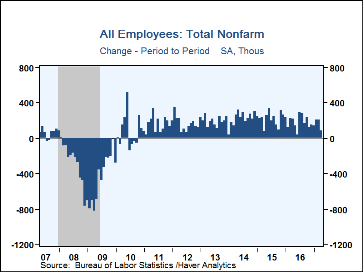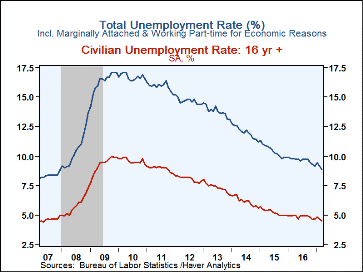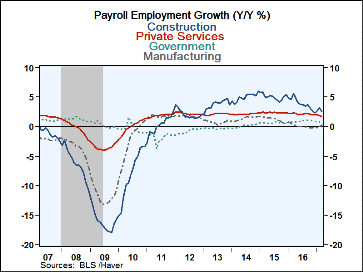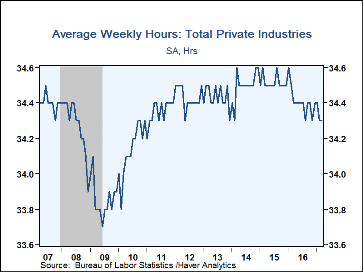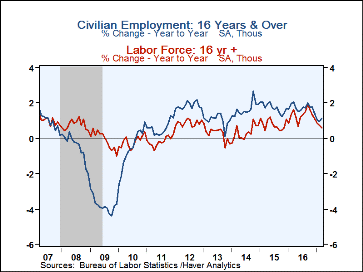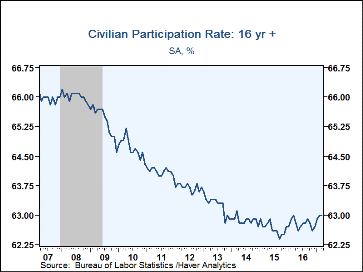 Global| Apr 07 2017
Global| Apr 07 2017U.S. Payroll Growth Is Disappointing, But Unemployment Rate Declines
by:Tom Moeller
|in:Economy in Brief
Summary
The labor market softened this winter. Nonfarm payrolls rose 98,000 (1.6% y/y) during March. The increase followed a 219,000 February rise and a 216,000 January gain. These figures together were revised down by 38,000. Expectations [...]
The labor market softened this winter. Nonfarm payrolls rose 98,000 (1.6% y/y) during March. The increase followed a 219,000 February rise and a 216,000 January gain. These figures together were revised down by 38,000. Expectations had been for a 178,000 increase in the Action Economics Forecast Survey. Average hourly earnings increased an expected 0.2% (2.7% y/y). The unemployment rate declined to 4.5%. Stability at 4.7% had been forecast. The overall unemployment rate, including marginally attached workers and those working part-time for economic reasons, fell to 8.9%, its lowest level since December 2007.
From the payroll survey, the weakness in recent monthly employment gains left the average increase during the first three months of 2017 at 178,000. That compares to a 187,000 average during all of last year. Employment growth likely has been affected by February's unusually warm temperatures. Construction sector employment improved just 6,000 last month following a 59,000 jump in February that was roughly a ten-year high. Factory sector employment rose 11,000 after a 26,000 increase. Mining sector jobs jumped 11,300 (0.7% y/y), the largest gain since June 2011.
In the private service-sector, the diminished 61,000 increase in payrolls reflected a 27,000 worker decline (+0.6% y/y) in trade, transportation & utilities employment after a 16,000 drop. Employment in the retail sector alone fell 29,700 (+0.3% y/y), about as it did in February. Leisure & hospitality jobs grew 9,000 (1.6% y/y) after a modest 27,000 increase. Professional & business service sector employment grew 56,000 (3.2% y/y), about as it has since early 2013. Education & health service sector employment rose 16,000 (2.3% y/y), the weakest gain since January of last year. Jobs in the leisure & hospitality sector nudged 9,000 higher (1.6% y/y), down sharply from the 30,000 to 40,000 readings of the last few years. Financial employment rose a weakened 9,000 (2.2% y/y).
Employment in the government sector rose 9,000 following a 2,000 decline. Local government hiring improved 9,000 (0.8% y/y), the strongest rise in six months. State government jobs nudged 1,000 higher (-0.1% y/y), on a par with the movement of the last year. The number of federal government jobs eased 1,000 (+1.1% y/y) and has been going nowhere for a year.
The length of the average workweek held steady at a reduced 34.3 hours, down from 34.5 hours averaged in 2014 and 2015. Factory sector hours dropped to 40.6, down from the 41.1 hour peak in 2014. Construction sector hours fell to 38.8, the weakest in six months. Professional & business service sector hours held steady m/m at 36.0 while financial activities hours worked eased to 37.7. Leisure & hospitality hours were roughly steady with last year's average at 26.0 hours. Aggregate hours worked (employment times hours) rose 1.5% (AR) during Q1, about the same as in the prior two quarters.
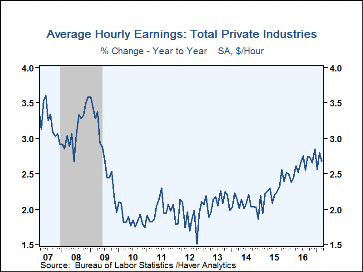 Average hourly earnings rose 0.2% (2.7% y/y) after a 0.3%
February rise, revised from 0.2%. The annualized 2.5% growth over the last three
months is down from 3.2% early last year. Construction sector earnings
gained 0.2% (2.4 y/y) while factory sector earnings remained unchanged for a
second straight month. Factory sector growth of 2.5% y/y was lower than 3.5%
last June. Private service sector earnings grew 0.2% (2.7% y/y) as professional
& business service sector pay jumped 0.9% (3.5% y/y). Information sector
earnings notched 0.1% higher (4.0% y/y) as did financial sector earnings (2.1%
y/y). Leisure & hospitality pay strengthened 0.5% (4.4% y/y) but education
& health sector earnings fell 0.2% (+1.8% y/y).
Average hourly earnings rose 0.2% (2.7% y/y) after a 0.3%
February rise, revised from 0.2%. The annualized 2.5% growth over the last three
months is down from 3.2% early last year. Construction sector earnings
gained 0.2% (2.4 y/y) while factory sector earnings remained unchanged for a
second straight month. Factory sector growth of 2.5% y/y was lower than 3.5%
last June. Private service sector earnings grew 0.2% (2.7% y/y) as professional
& business service sector pay jumped 0.9% (3.5% y/y). Information sector
earnings notched 0.1% higher (4.0% y/y) as did financial sector earnings (2.1%
y/y). Leisure & hospitality pay strengthened 0.5% (4.4% y/y) but education
& health sector earnings fell 0.2% (+1.8% y/y).
The household sector figures indicated that the unemployment rate fell to 4.5%, its lowest level since May 2007. Employment jumped 472,000. Twelve-month growth of 1.1% was down, however, from 1.7% during all of last year. The labor force increase of 145,000 left y/y growth at a reduced 0.6%. The population grew 0.7% y/y so the labor force participation rate held steady m/m at 63.0%, though that was up from its September 2015 low of 62.4%. The average duration of unemployment held fairly steady at 25.3 weeks, down from 39.4 in 2012. Growth in those not in the labor force fell to 0.5% from 2.9% during all of 2010.
By educational attainment, the unemployment rate for individuals with less than a high school diploma fell sharply m/m to 6.8%. For those with a high school diploma, but no college the rate eased to 4.9%. For high school graduates with less than a bachelors degree, unemployment fell to 3.7%, and for those with a higher degree, it ticked up to 2.5%.
The teenage unemployment rate declined m/m to 13.7%, down from 25.9% in 2010. For individuals aged 20-24 years, the rate of 7.3% was down from 15.5% in 2010. For individuals over age 25, the jobless rate of 3.8% was down from 8.2% in 2010.
The Labor Market for Recent College Graduates from the Federal Reserve Bank of New York can be found here.
The labor market data are contained in Haver's USECON database. Detailed figures are in the EMPL and LABOR databases. The expectations figure is in the AS1REPNA database.
| Employment: (SA, M/M Change, 000s) | Mar | Feb | Jan | Mar Y/Y | 2016 | 2015 | 2014 |
|---|---|---|---|---|---|---|---|
| Payroll Employment | 98 | 219 | 216 | 1.6% | 1.7% | 2.1% | 1.9% |
| Previous | -- | 235 | 238 | -- | -- | -- | -- |
| Manufacturing | 11 | 26 | 12 | 0.3 | 0.1 | 1.2 | 1.4 |
| Construction | 6 | 59 | 34 | 2.9 | 3.9 | 5.0 | 5.0 |
| Private Service-Producing | 61 | 125 | 153 | 1.8 | 2.1 | 2.4 | 2.1 |
| Government | 9 | -2 | 12 | 0.6 | 0.9 | 0.7 | 0.1 |
| Average Weekly Hours - Private Sector | 34.3 | 34.3 | 34.4 | 34.4 | 34.4 | 34.5 | 34.5 |
| Private Sector Average Hourly Earnings (%) | 0.2 | 0.3 | 0.2 | 2.7 | 2.6 | 2.3 | 2.1 |
| Unemployment Rate (%) | 4.5 | 4.7 | 4.8 | 5.0 | 4.8 | 5.3 | 6.2 |
Tom Moeller
AuthorMore in Author Profile »Prior to joining Haver Analytics in 2000, Mr. Moeller worked as the Economist at Chancellor Capital Management from 1985 to 1999. There, he developed comprehensive economic forecasts and interpreted economic data for equity and fixed income portfolio managers. Also at Chancellor, Mr. Moeller worked as an equity analyst and was responsible for researching and rating companies in the economically sensitive automobile and housing industries for investment in Chancellor’s equity portfolio. Prior to joining Chancellor, Mr. Moeller was an Economist at Citibank from 1979 to 1984. He also analyzed pricing behavior in the metals industry for the Council on Wage and Price Stability in Washington, D.C. In 1999, Mr. Moeller received the award for most accurate forecast from the Forecasters' Club of New York. From 1990 to 1992 he was President of the New York Association for Business Economists. Mr. Moeller earned an M.B.A. in Finance from Fordham University, where he graduated in 1987. He holds a Bachelor of Arts in Economics from George Washington University.


